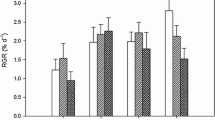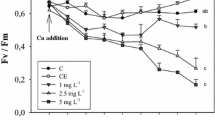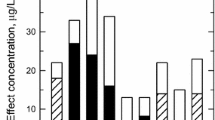Abstract
Atrazine (2-chloro-4-ethylamino-6-isopropylamine-s-triazine) concentrations of 1,000 ppm either killed or eliminated the escape response (considered to be analogous to death) ofUca pugnax in laboratory experiments in August 1977. Adverse effects were observed at concentrations as low as 100 ppm and the severity was dependent on size and sex of the crab. However, in subsequent experiments, each with a new group of crabs, the effects of atrazine became smaller and smaller until a November experiment when no deleterious effects were observed even when exposed to 1,000 ppm. Experiments in August, 1978 confirmed the data obtained 1 year earlier. Ecological and physiological considerations of this seasonal variation in response are discussed. Crabs fed for 20 days with detritus wetted with 10−4 M atrazine were not adversely affected. Crabs exposed to a single application of 0, 100, 1,000, and 10,000 ppm atrazine in the field and in microecosystems were adversely affected only by the 10,000-ppm rate. Toxicity of atrazine to the larval stage of the crab was not investigated.
Similar content being viewed by others
Literature Cited
Anonymous. 1977. Assessing Nonpoint Source Pollution: A Detailed Study of a Rural Watershed in the Coastal Plain of Maryland. Chesapeake Bay Center for Environmental Studies. Smithsonian Institution, July, 1977. 59 p.
Everest, J. W. 1978. Predicting phosphorus movement and pesticide action in salt marshes with microecosystems. Ph.D. Dissertation. Auburn University, Auburn, Alabama 88 p.
—, andD. E. Davis. 1977. Microecosystems for herbicide research and other studies, p. 167–171.In B. Truelove (ed.). Research Methods in Weed Science 2nd Ed. South. Weed Sci. Soc., Auburn, Alabama.
Haines, E. B. Relation between the stable carbon isotope composition of fiddler crabs, plants, and soils in a salt marsh.Limnol. Oceanogr. 21:880–883.
Newell, R. C. 1975. Factors controlling metabolic capacity adaption in marine invertebrates, p. 112–127.In F. J. Vernberg (ed.). Physiological Ecology of Estuarine Organisms. University of South Carolina Press. Columbia, South Carolina. 397 p.
Odum, W. E., G. M. Woodwell, andC. F. Wurster. 1969. DDT residues absorbed from organic detritus by fiddler crabs.Science 164:576–577.
Pillai, C. G. P., J. D. Weete, andD. E. Davis. 1977. Metabolism of atrazine bySpartina alterniflora. I. Chloroform-soluble metabolites.J. Agric. Food Chem. 25:852–855.
Plumley, G. P. 1978. Atrazine effects on salt marsh edaphic algae. M.S. Thesis. Auburn University, Auburn, Alabama. 89 p.
Steel, R. G. D., andJ. H. Torrie. 1970. Principles and Procedures of Statistics. McGraw Hill Book Co., Inc. New York. 481 p.
Teal, J. M. 1959. Respiration of crabs in Georgia salt marshes and its reaction to their ecology.Physiol. Zool. 32:1–14.
Vernberg, F. J., andW. B. Vernberg. 1975. Adaptations to extreme environments, p. 165–180.In F. J. Vernberg (ed.). Physiological Ecology of Estuarine Organisms. University of South Carolina Press. Columbia, South Carolina.
Vernberg, W. B., P. J. DeCoursey, andJ. O'Hara. 1974. Multiple environmental factor effects on physiology and behavior of the fiddler crab,Uca pugilator, p. 381–425.In F. J. Vernberg (ed.). Pollution and Physiology of Marine Organisms. Academic Press, New York.
Ward, D. V., andD. A. Busch. 1976. Effects of Temefos, an organophosphorous insecticide, on survival and escape behavior of the marsh fiddler crabUca pugnax.Oikos 27:331–335.
—,B. L. Howes, andD. Ludwig. 1976. Interactive effects of predation pressure and insecticide (Temefos) toxicity on populations of the marsh fiddler crab,Uca pugnax.Mar. Biol. 35:119–126.
WSSA Herb. Handbook Comm. 1979. Herbicide Handbook of the Weed Science Society of America. 4th Ed. Sci. Soc. Am. Champaigne, Illinois. 479 p.
Wolf, P. L., S. F. Shanholtzer, andR. J. Reimold. 1975. Population estimates forUca pugnax (Smith, 1870) on the Duplin Estuary Marsh, Georgia, U.S.A.Crustaceana 29:79–91.
Author information
Authors and Affiliations
Rights and permissions
About this article
Cite this article
Plumley, F.G., Davis, D.E., McEnerney, J.T. et al. Effects of a photosynthesis inhibitor, atrazine, on the salt-marsh fiddler crab,Uca pugnax (Smith). Estuaries 3, 217–223 (1980). https://doi.org/10.2307/1352072
Issue Date:
DOI: https://doi.org/10.2307/1352072




